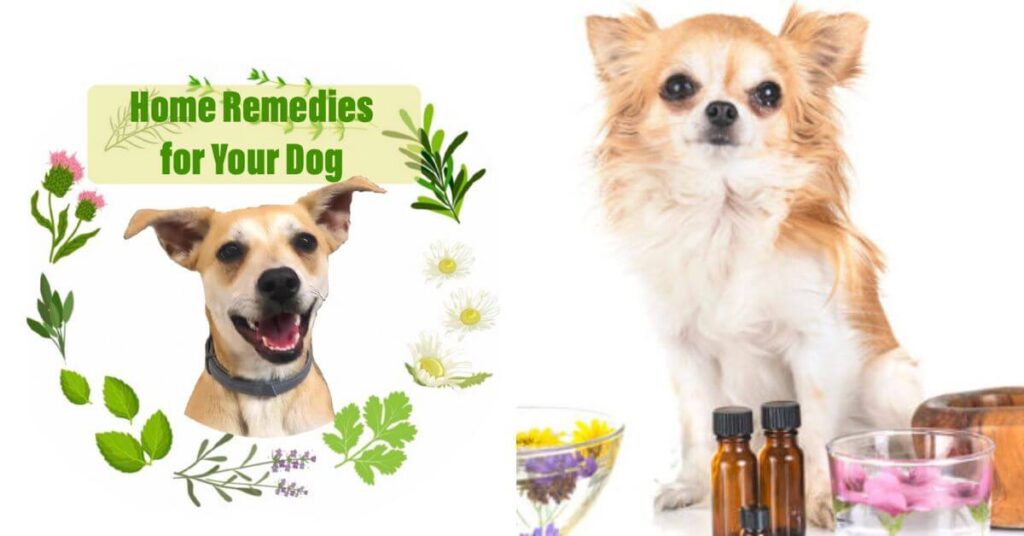Have you ever looked at your pup and wondered if there’s a gentler, more natural way to help them feel better? You’re in the right place! This guide to Dog Home Remedies offers science‑based, vet‑backed solutions for common canine issues. Packed with practical tips, engaging advice, and empathetic tone, you’ll feel confident caring for your furry family member using natural, easy‑to‑find aids.
Let’s jump right in and explore natural ways to soothe itchy skin, upset tummies, mild injuries, and more all while keeping it fun and energetic!
Why Choose Dog Home Remedies?
Choosing Dog Home Remedies isn’t just about saving a trip to the vet it’s about building a stronger, more intuitive bond with your pup while using gentle, proven methods to address minor issues before they escalate. Here’s why more pet parents are embracing these natural options:
1. Safer for Sensitive Dogs
Some dogs react poorly to medications, especially if they have allergies or sensitive stomachs. Natural remedies like pumpkin for digestive issues or oatmeal for itchy skin are often milder and easier on your pup’s system.
2. You Know Exactly What’s Going In
Most home remedies use ingredients you already trust like coconut oil, chamomile tea, or bone broth. There are no hidden chemicals or synthetic fillers, which is especially important for dogs with food sensitivities.
3. Budget-Friendly and Accessible
Vet visits and medications can get pricey fast. Many Dog Home Remedies use inexpensive, pantry-staple items that you can whip up in minutes. Think: no need to break the bank for every sniffle or itch.
4. Quick Relief for Minor Issues
For non-emergency problems like dry skin, minor scrapes, or stress during thunderstorms, home remedies can bring instant comfort. You don’t always need to wait for an appointment to give your dog some much-needed relief.
5. Backed by Science and Tradition
Remedies like turmeric for joint inflammation or probiotics for gut health have scientific support and centuries of traditional use. You’re not just guessing you’re using time-tested solutions with real biological benefits.
6. Strengthens Your Bond
Taking the time to prepare and apply a soothing balm, massage a sore leg, or cook up a tummy-friendly treat shows your dog love in a way they understand through touch, smell, and attention. It deepens trust and connection.
7. Encourages Holistic Wellness
Dog home remedies don’t just treat symptoms they often support overall wellness. A daily dose of coconut oil, for instance, helps coat shine, digestion, and even immune function.
Soothing an Upset Tummy: Gentle Dog Home Remedies That Work
If your dog has ever dealt with a gurgly belly, unexpected vomit, or loose stools, you know how concerning it can be. The good news? Mild tummy troubles can often be managed right at home using safe, natural Dog Home Remedies.
Let’s walk through the most effective and vet-approved ways to calm your dog’s upset stomach using everyday ingredients you probably already have.
1. Plain Pumpkin (Not Pie Filling!)
Why it works: Pumpkin is rich in soluble fiber, which helps regulate digestion and firm up stool.
How to use it:
- For diarrhea or constipation, feed 1 teaspoon per 10 pounds of body weight, once or twice a day.
- Make sure it’s plain canned pumpkin no added sugars or spices.
Pro tip: You can freeze pumpkin in silicone molds for quick, ready-to-go portions.
2. Boiled Chicken and White Rice
Why it works: A bland diet gives your dog’s digestive system a break. Lean chicken provides protein without fat, and white rice is easy to digest.
How to use it:
- Use skinless, boneless chicken breast. Boil with plain water no salt or spices.
- Mix equal parts chicken and rice. Serve in small amounts (½ cup for small dogs, 1 cup+ for larger dogs) up to three times a day.
Tip: Once your dog starts feeling better, gradually reintroduce their regular food.
3. Bone Broth for Hydration
Why it works: A warm cup of homemade bone broth is both hydrating and healing. It’s rich in nutrients like collagen and glycine, which support gut lining repair.
How to make it:
- Simmer beef bones or chicken carcass for 12–24 hours.
- Strain thoroughly and let it cool.
- Offer a few tablespoons throughout the day, especially if your dog isn’t eating solid food.
Caution: Remove all bones and fat. Never use onions or garlic they’re toxic to dogs.
4. Slippery Elm Bark Powder
Why it works: This herbal remedy forms a gel-like substance in the stomach that coats and soothes irritated tissue.
How to use it:
- Mix ¼ teaspoon of powdered slippery elm into a small amount of food or yogurt.
- Use once or twice daily until symptoms resolve.
Note: Safe for short-term use. Always talk to your vet before long-term use or if your dog is on medication.
5. Plain Yogurt or Kefir (No Sugar)
Why it works: These are natural sources of probiotics that help restore good gut bacteria, especially after vomiting or diarrhea.
How to use it:
- Give 1 teaspoon to small dogs, 1 tablespoon to medium/large dogs.
- Choose plain, unsweetened varieties no artificial sweeteners like xylitol, which is toxic.
6. Mashed Banana
Why it works: Bananas are gentle on the stomach and contain potassium, which supports hydration and nerve function.
How to use it:
- Mash a small piece and add it to bland meals.
- Serve sparingly too much can cause constipation.
7. Ginger Root (Small Doses!)
Why it works: Ginger helps with nausea and has mild anti-inflammatory effects.
How to use it:
- Steep a small slice of fresh ginger in hot water for 5 minutes.
- Cool completely. Offer a few spoonfuls of the tea to your dog.
Warning: Avoid powdered or flavored ginger. Always start small especially for small breeds.
When to See the Vet
While these Dog Home Remedies can be incredibly helpful for short-term digestive upsets, not every stomach issue should be treated at home. Call your vet if:
- Vomiting or diarrhea lasts more than 24–48 hours
- Blood is present in stool or vomit
- Your dog becomes lethargic, dehydrated, or refuses food
- There’s known exposure to toxins, spoiled food, or foreign objects
Calming Itchy, Flaky Skin: Natural Dog Home Remedies That Bring Relief
When your pup starts scratching non-stop, biting at their paws, or showing signs of dandruff or hot spots, it’s more than just an inconvenience it can be a sign their skin barrier is irritated, dry, or inflamed.
The good news? Many cases of itchy, flaky skin can be eased right at home with gentle, science-backed Dog Home Remedies that nourish and soothe without harsh chemicals.

Let’s explore what really works and why.
1. Oatmeal Baths for Whole-Body Soothing
Why it works: Oatmeal contains compounds called avenanthramides and saponins, which reduce inflammation and cleanse the skin naturally.
How to use it:
- Grind plain, unsweetened oats into a fine powder.
- Add to warm bathwater and stir until milky.
- Let your dog soak for 10–15 minutes, massaging the water into their coat.
Bonus tip: Don’t rinse it off completely. Let a light coating remain for extended relief.
2. Virgin Coconut Oil (Topical & Dietary)
Why it works: Coconut oil is antimicrobial, antifungal, and deeply moisturizing. It’s rich in lauric acid, which helps repair the skin’s protective barrier.
Topical use:
- Warm a small amount in your hands and massage it into flaky or red areas once daily.
- Great for dry noses, paws, elbows, and hotspots.
Dietary support:
- Add ¼ teaspoon per 10 lbs of body weight to food, once daily.
- Supports coat health and immune function from the inside out.
3. Apple Cider Vinegar (Diluted Spray)
Why it works: Apple cider vinegar helps rebalance skin pH and kills yeast or bacteria that may be worsening the itch.
How to use it:
- Mix 50% raw apple cider vinegar with 50% water in a spray bottle.
- Spray onto affected areas, avoiding open wounds or raw spots.
Caution: Never use on broken skin it will sting!
4. Chamomile or Calendula Tea Rinse
Why it works: Both herbs contain natural anti-inflammatory and antimicrobial properties that calm irritated, red, or flaky patches.
How to use it:
- Brew strong tea using 2–3 tea bags in 1 cup of boiling water. Let it cool completely.
- Pour over irritated skin or apply with a clean cloth.
- Use daily until symptoms improve.
5. Add Omega-3s to Their Diet
Why it works: Omega-3 fatty acids (EPA & DHA) support skin hydration and reduce inflammation. They’re essential for dogs with dry skin or allergies.
Sources:
- Fish oil capsules or liquid (from sardines, salmon, anchovies)
- Flaxseed oil (if your dog doesn’t tolerate fish)
Dosage:
- 75–100 mg of combined EPA/DHA per 10 lbs of body weight per day.
Bonus: Omega-3s also support joint, heart, and brain health.
6. Aloe Vera Gel (For Hotspots & Itchy Patches)
Why it works: Aloe is known for its cooling, antibacterial properties that promote healing in dry or inflamed skin.
How to use it:
- Use pure, unscented, additive-free aloe gel (or directly from an aloe plant leaf).
- Apply thinly to red or itchy areas. Let air dry.
Note: Always check for alcohol or fragrance many store-bought gels contain ingredients harmful to dogs.
7. Eliminate Environmental Triggers
Sometimes itchy skin isn’t just about dryness it’s about allergies. Common culprits include:
- Grasses or pollen
- Dust mites
- Household cleaners
- Grain-heavy or low-quality diets
Remedy:
- Wipe paws and bellies with a damp cloth after outdoor play.
- Switch to a limited ingredient or grain-free diet if food sensitivity is suspected.
- Use hypoallergenic shampoos and avoid chemical room sprays or floor cleaners.
When to Talk to the Vet
While most minor dry or itchy skin issues respond well to these Dog Home Remedies, contact your vet if:
- Itching is constant or keeps your dog up at night
- You see open sores, pus, or bleeding
- Hair loss is widespread
- Symptoms don’t improve after a few days of natural care
Minor Cuts, Scrapes & Hot Spots: Dog Home Remedies That Heal Naturally
Dogs are curious by nature they run, roll, dig, and explore with zero regard for thorns, rough pavement, or sharp edges. So it’s no surprise that minor cuts, scrapes, and hot spots (those nasty, inflamed patches they just won’t stop licking) are common.
While deeper wounds or infected areas require veterinary care, you can absolutely treat minor skin injuries at home with safe and effective Dog Home Remedies that promote healing and comfort.
1. Clean the Wound Gently (But Thoroughly)
Why it matters: Bacteria love open skin. The first step in healing is always proper cleansing to prevent infection.
How to clean:
- Rinse with lukewarm water or use a saline solution (1 tsp salt per cup of warm water).
- Gently pat dry with a clean towel don’t rub.
- If there’s debris (grass, dirt), use sterilized tweezers to remove it carefully.
Caution: Don’t use hydrogen peroxide or alcohol they damage healthy tissue and delay healing.
2. Chamomile or Calendula Tea Spray
Why it works: These herbs are natural antiseptics and calm inflammation. They’re also great for soothing itchiness from hot spots.
How to use:
- Steep 2–3 tea bags in hot water for 10 minutes. Let it cool completely.
- Pour into a spray bottle and mist the affected area 2–3 times per day.
Alternative: Dab the tea on with a clean cloth for smaller wounds or sensitive areas.
3. Witch Hazel (Alcohol-Free)
Why it works: Witch hazel has astringent properties that dry up moist wounds (like oozing hot spots), reduce itching, and prevent bacterial buildup.
How to apply:
- Use a cotton pad soaked in alcohol-free witch hazel.
- Gently pat the wound or hot spot once or twice daily.
- Avoid if skin is cracked or bleeding.
4. Cold Compress for Swelling or Hot Spots
Why it works: Applying a cold compress helps reduce swelling, pain, and heat in inflamed areas especially early hot spot stages.
How to use:
- Wrap ice or a chilled gel pack in a towel.
- Apply for 5–10 minutes, 2–3 times a day.
- Keep your dog still and comforted during the process.
5. Coconut Oil for Moisture & Antibacterial Protection
Why it works: Virgin coconut oil not only moisturizes dry, cracked skin but also forms a natural barrier against bacteria and fungi.
How to apply:
- Dab a thin layer onto a clean, dry wound or healing hotspot.
- Use sparingly to avoid excess licking.
- Reapply 1–2 times daily.
6. Aloe Vera Gel (Pure, Additive-Free)
Why it works: Aloe vera soothes burns, itchiness, and redness while promoting cell regeneration. It’s a natural anti-inflammatory and mild antiseptic.
How to use:
- Use 100% pure aloe vera gel (from the plant or alcohol-free store version).
- Apply a small amount directly to the wound or inflamed area.
- Let it air dry. Prevent licking if possible.
7. Elizabethan Collar or Soft Cone
Why it helps: Constant licking slows healing and can worsen wounds. A soft cone or inflatable collar helps protect the area while your remedies work.
Pro tip: Some dogs respond better to soft, cloth-style collars versus hard plastic ones.
Recognizing & Treating Hot Spots at Home
What is a hot spot?
A moist, red, irritated area of skin often caused by excessive licking, allergies, or moisture trapped under fur.
How to treat a mild hot spot at home:
- Trim the fur around the area to allow air circulation.
- Clean gently with a saline rinse or witch hazel.
- Apply chamomile tea or aloe vera to soothe.
- Use a cone to stop licking.
- Monitor for improvement over 24–48 hours.
When to Call the Vet
Not all wounds are safe for home treatment. Contact your vet if:
- The wound is deep, bleeding heavily, or has jagged edges
- There’s pus, severe swelling, or foul odor (signs of infection)
- Your dog is in significant pain, limping, or lethargic
- The area doesn’t improve within 48 hours or worsens
Managing Joint Pain & Stiffness: Natural Dog Home Remedies That Bring Comfort
As your dog gets older or if you have a large or high-energy breed you might notice subtle signs of discomfort: hesitating to jump, stiffness after naps, or slow movement on walks. Joint pain and stiffness are common in dogs, especially due to arthritis, hip dysplasia, or even prior injuries. The great news? You don’t always need expensive medications to help.
With the right Dog Home Remedies, you can naturally ease their discomfort, support mobility, and keep their tail wagging a whole lot longer.
Let’s dive into the safest, most effective ways to manage your dog’s joint pain at home.
1. Turmeric (Golden Paste)
Why it works: Turmeric contains curcumin, a natural anti-inflammatory and antioxidant. It helps reduce joint swelling and pain in arthritic dogs. When combined with black pepper, its absorption increases significantly.
How to make it:
- Mix ½ cup turmeric powder, 1 cup water, 1½ tsp black pepper, and ¼ cup coconut oil.
- Simmer over low heat until it forms a paste. Cool and store in the fridge for up to 2 weeks.
Dosage: Feed ¼ teaspoon per 10 lbs of body weight, once or twice daily with food.
Caution: Start slow too much may cause stomach upset. Always consult your vet before long-term use, especially if your dog is on medication.
2. Warm Compresses for Sore Joints
Why it works: Heat therapy improves circulation, relaxes tense muscles, and helps ease stiffness, particularly in colder months or after naps.
How to use it:
- Soak a clean towel in warm (not hot) water.
- Wring it out and apply it gently to the sore joint.
- Hold for 5–10 minutes, twice daily.
Tip: Use this time to bond with your dog massage during or after the compress for added relief.
3. Omega-3 Fatty Acids (Fish Oil)
Why it works: Omega-3s (EPA and DHA) are clinically proven to reduce inflammation and support cartilage health. They also improve skin, coat, and heart function.
How to use:
- Choose a high-quality fish oil supplement (salmon, sardine, or anchovy-based).
- Follow the recommended dosage on the label, based on your dog’s weight.
- Mix it into meals to avoid fishy breath from licking the spoon!
Pro tip: Choose dog-specific formulas to avoid excess vitamin A, which can be toxic in high doses.
4. Gentle Massage for Mobility Support
Why it works: Massage helps increase flexibility, reduce muscle tension, and improve your dog’s comfort level.
How to give a massage:
- Use flat fingers to gently rub circular motions over shoulders, hips, or any area your dog favors.
- Start with light pressure. Watch your dog’s reaction stop if they pull away or seem uncomfortable.
- Aim for 5–10 minutes daily or after long walks.
Bonus: Builds trust and strengthens your bond.
5. Orthopedic Dog Bed
Why it matters: Hard floors or low-quality beds can worsen joint pain. Orthopedic beds support joints, reduce pressure points, and promote deep rest.
What to look for:
- High-density memory foam
- Low entry for easy access
- Waterproof liner and washable cover
Optional add-ons: Heated pads or cooling gels for seasonal relief.
6. Maintain a Healthy Weight
Why it’s critical: Every extra pound puts stress on your dog’s joints. Even just 5 pounds of excess weight can accelerate arthritis or joint wear.
What to do:
- Feed portion-controlled, high-quality food.
- Use low-calorie treats or replace with carrot sticks.
- Add light daily walks or gentle indoor play to their routine.
Tip: Regular weight checks can be as important as vet visits for long-term joint health.
7. Anti-Inflammatory Treats & Foods
Natural options to include in meals:
- Sweet potatoes (rich in beta-carotene)
- Blueberries (high in antioxidants)
- Bone broth (for joint and gut support)
- Green-lipped mussel powder (natural joint support)
Always introduce new foods gradually and observe for allergies or sensitivities.
8. Controlled Low-Impact Exercise
Why it helps: Movement keeps joints lubricated and prevents stiffness, but the wrong exercise can cause more harm than good.
Best options:
- Short, frequent walks instead of long hikes
- Swimming (low impact and full-body)
- Treadmill walking (if your dog tolerates it well)
Avoid jumping, stairs, or rough play during flare-ups.
9. Topical Arnica or Comfrey Cream
Why it works: Both herbs are known for anti-inflammatory effects. Arnica reduces bruising and pain, while comfrey promotes tissue repair.
How to apply:
- Use dog-safe versions only (many human creams contain unsafe additives).
- Apply a small amount to the affected joint once or twice daily.
- Prevent licking until it’s fully absorbed.
Tip: Provide Mental Stimulation
Dogs in pain may become depressed or withdrawn. Keep their spirits high with brain games, puzzle toys, scent-based play, or short training sessions.
A happy brain can actually dull the perception of physical pain.
When to See the Vet
While these Dog Home Remedies can make a huge difference, always consult your vet if:
- Your dog has sudden limping or swelling
- Pain seems to worsen over time
- They cry out when touched or refuse to move
- Prescription support may be needed (NSAIDs, joint injections, etc.)
Your vet may also recommend joint X-rays or supplements like glucosamine, chondroitin, or prescription diets for advanced cases.
Best Dog Health Supplement:
Fresh Breath & Oral Health: Dog Home Remedies for a Cleaner Smile
Does your dog’s breath knock you over before they even say “woof”? You’re not alone bad dog breath is one of the most common complaints from pet parents. But did you know it can be a sign of deeper issues like plaque buildup, gum disease, or poor diet?
Thankfully, there are natural, gentle Dog Home Remedies that can help freshen their breath, support oral hygiene, and keep those puppy kisses a lot more enjoyable.
Let’s look at easy and effective ways to improve your dog’s oral health right from your kitchen.
1. Brushing With Dog-Safe Toothpaste
Why it works: Brushing removes plaque before it hardens into tartar, the root cause of bad breath and gum disease.
How to do it:
- Use a dog-specific toothbrush or finger brush.
- Choose a vet-approved, enzyme-based dog toothpaste (never use human toothpaste xylitol is toxic!).
- Start slow, reward often, and aim to brush 3–4 times per week.
Pro Tip: For fussy dogs, dip the brush in bone broth or coconut oil first.
2. Coconut Oil for Dental Health
Why it works: Coconut oil has natural antimicrobial properties that help fight oral bacteria and reduce inflammation in the gums.
How to use:
- Rub a small amount directly on your dog’s gums and teeth.
- Or mix ¼ to ½ teaspoon into their food daily, depending on their size.
Bonus: It also improves coat health and digestion.
3. Parsley & Mint Water
Why it works: These herbs contain chlorophyll, which naturally deodorizes breath and reduces oral bacteria.
How to use:
- Boil a handful of fresh parsley or mint in water. Let it cool.
- Add a tablespoon or two to your dog’s water bowl daily.
Caution: Avoid essential oils or concentrated herb extracts they’re too potent for dogs.
4. Raw Bones or Dental Chews
Why it works: Chewing naturally scrapes plaque off teeth and stimulates saliva, which cleanses the mouth.
Options:
- Raw, meaty bones (like beef knuckles) under supervision
- Vet-approved dental chews with the VOHC (Veterinary Oral Health Council) seal
Warning: Never give cooked bones they can splinter and cause serious injury.
5. Crunchy Fruits & Veggies
Why it works: Crunchy produce like carrots and apples can help clean teeth and freshen breath naturally.
How to serve:
- Cut into small chunks to prevent choking
- Offer raw or lightly chilled for extra crunch
Avoid: Grapes, raisins, onions, and other toxic foods for dogs.
6. Apple Cider Vinegar (ACV) in Water
Why it works: ACV has antimicrobial properties that may help reduce oral bacteria contributing to foul breath.
How to use:
- Add ½ to 1 teaspoon of raw, organic ACV to your dog’s water bowl once a day.
Caution: Introduce slowly and watch for any signs of tummy upset.
7. Probiotic Supplements
Why it works: Oral health starts in the gut. A balanced microbiome helps prevent yeast overgrowth and inflammation that lead to bad breath.
How to use:
- Add a dog-specific probiotic to meals
- Plain yogurt (unsweetened) works as a short-term, food-based probiotic
8. Homemade Dental Dog Treats
Why it works: DIY treats made with natural ingredients can help clean teeth and freshen breath while avoiding synthetic additives.
Simple recipe idea:
- Mix coconut oil, parsley, mint, and oat flour
- Shape into bite-sized pieces
- Freeze or bake lightly for longer shelf life
Signs of Deeper Dental Issues
If your dog’s breath smells sour, metallic, or rotten even after home care it could be a red flag for:
- Gingivitis (inflamed gums)
- Tooth abscess or infection
- Kidney or liver disease (systemic causes of bad breath)
See a vet if:
- You notice bleeding gums, loose teeth, or drooling
- Breath smells extremely foul or like ammonia
- Your dog avoids eating or shows signs of pain when chewing

Eye & Ear Gently Cleaners: Safe Dog Home Remedies for Clear Senses
Your dog’s eyes and ears are windows to their world and when they’re red, itchy, or gunky, it can cause discomfort or even infection. While serious issues should always be checked by a vet, many mild irritations and routine cleanups can be handled with gentle, natural Dog Home Remedies.
Let’s explore vet-safe ways to clean and care for your dog’s sensitive eyes and ears using simple, non-toxic ingredients you probably already have at home.
Gentle Dog Home Remedies for Eye Cleaning
Chamomile Tea Rinse (Anti-inflammatory & Soothing)
Why it works: Chamomile contains natural antiseptic and anti-inflammatory properties that can help reduce redness, discharge, and mild irritation.
How to use it:
- Steep 1–2 chamomile tea bags in hot water. Let it cool completely.
- Soak a clean, soft cloth or sterile cotton pad in the tea.
- Gently wipe the area around the eye never pour or drip directly into the eye.
- Use a fresh cloth for each eye to prevent cross-contamination.
Best for: Tear stains, mild discharge, or eye puffiness due to allergies.
2. Saline Solution (Everyday Eye Rinse)
Why it works: A homemade saline rinse mimics the body’s natural tears and gently cleans dust or debris from the eyes.
How to make it:
- Mix 1 teaspoon of salt into 1 cup of distilled or boiled (cooled) water.
- Use an eye dropper or soaked gauze pad to flush or wipe around the eye.
Do not: Use contact lens solution it often contains chemicals not safe for dogs.
Natural Dog Home Remedies for Ear Cleaning
3. Apple Cider Vinegar (ACV) and Water Solution
Why it works: ACV helps break down wax, fight bacteria and yeast, and restore the ear’s natural pH.
How to use:
- Mix equal parts raw, organic apple cider vinegar and water.
- Dampen a cotton ball (never a Q-tip!) and gently wipe the outer ear and folds.
- Use once weekly for maintenance or after baths/swimming.
Caution: Never use on red, inflamed, bleeding, or visibly painful ears. Vinegar will sting if there are open sores.
4. Witch Hazel (Alcohol-Free Only)
Why it works: Witch hazel is a gentle astringent that helps dry out excess moisture, reduce swelling, and clean mild ear wax buildup.
How to use:
- Apply with a cotton pad or ball to wipe out the ear canal’s visible parts.
- Use sparingly about once every 10–14 days unless your vet recommends more.
Important: Choose alcohol-free versions only to avoid burning or drying delicate tissues.
5. Coconut Oil (Antifungal and Moisturizing)
Why it works: Coconut oil can soothe itchy ears and protect against yeast infections with its natural antibacterial and antifungal properties.
How to use:
- Warm a small amount between your fingers.
- Apply gently inside the ear flap or outer canal with your fingertip or cotton swab.
- Great for dogs prone to ear dryness or seasonal itch.
Signs You Should NOT Use Home Remedies
If your dog shows any of these symptoms, skip the home care and see a vet immediately:
- Excessive head shaking or pawing at ears
- Foul odor or black/yellow discharge
- Swelling or visible wounds in the eye/ear
- Squinting, cloudy cornea, or bloodshot eyes
- Sensitivity to touch near the head
These may indicate ear infections, ulcers, or foreign objects all of which require medical treatment.
Tip: Prevent Issues Before They Start
- Routine checks: Look inside ears and around eyes weekly.
- After walks/swims: Dry ears with a towel or cotton to prevent moisture buildup.
- Balanced diet: Supports immune health, which reduces chronic inflammation and infections.
- Allergy control: Skin sensitivities often show up as eye or ear issues. Managing allergens helps reduce flare-ups.
Important Safety Tips for Using Dog Home Remedies
Natural Dog Home Remedies can be incredibly effective, but just because something is natural doesn’t always mean it’s safe. Your dog’s body is unique and they can react differently to herbs, oils, or foods than we do. To keep your pup safe while treating them at home, follow these essential safety tips:
1. Always Check Dosage Carefully
Too much of a good thing like turmeric, coconut oil, or apple cider vinegar can lead to stomach upset, diarrhea, or worse.
✅ Start small and increase gradually.
✅ Base dosing on body weight.
✅ When in doubt, consult your vet before giving any supplement or herb.
2. Avoid Harmful Ingredients
Many everyday substances that are harmless to humans are toxic to dogs.
NEVER use:
- Essential oils (like tea tree, clove, or peppermint) without guidance
- Grapes, raisins, onions, garlic, or xylitol (commonly in toothpaste/gum)
- Human medications or creams unless prescribed by a vet
3. Know When to See a Vet
Dog Home Remedies are best for mild, non-emergency conditions. Don’t delay professional care if:
- Symptoms last more than 48 hours
- There’s vomiting, lethargy, or refusal to eat
- You notice bleeding, pus, swelling, or pain
- Your dog shows signs of serious illness (e.g., seizures, collapse, labored breathing)
4. Use Topicals Safely
Your dog will lick almost anything you put on their body.
✅ Use pet-safe topical remedies only (like food-grade coconut oil or aloe).
✅ Apply when your dog is calm or distracted.
✅ Use cones or clothing to prevent excessive licking, especially after applying oils or creams.
5. Sanitize Tools & Surfaces
Infections can spread easily during wound care or ear cleaning.
✅ Always use clean, sterilized tools.
✅ Wash your hands before and after treatment.
✅ Avoid sharing towels or brushes between pets.
6. Don’t Mix Remedies & Medications Without Advice
Some herbs, supplements, or oils may interfere with prescription drugs.
✅ If your dog is on medication, check with your vet before starting any new remedy especially turmeric, fish oil, CBD, or herbal tinctures.
7. Observe Your Dog Closely
Dogs can’t tell you if something’s wrong, so watch their body language.
Warning signs include:
- Excessive drooling
- Rapid breathing or panting
- Restlessness or hiding
- Swelling, redness, or skin reactions after applying a remedy
8. Not All Remedies Fit All Dogs
What works for one dog may not be safe for another.
Puppies, senior dogs, pregnant females, or dogs with chronic illnesses (like liver or kidney disease) need customized care.
9. Keep a Pet Health Journal
Track what remedies you try, dosages, reactions, and improvements.
Helps you fine-tune what works and gives your vet helpful info if needed later.
10. Don’t Skip Regular Vet Visits
Even the most natural, effective Dog Home Remedies are complementary, not a replacement for routine vet care.
✅ Stick to regular check-ups, dental cleanings, and vaccinations.
✅ Ask your vet how to combine holistic care with their medical plan safely.
Making simple, thoughtful Dog Home Remedies part of your everyday canine care routine brings both comfort and connection. These gentle DIY solutions can ease digestion, soothe skin and joints, and support your pup’s mental wellbeing. Always partner with your vet for personalized advice, especially for long‑term or serious concerns. With the right mix of nature, love, and science, your dog will enjoy healthier, happier days and you’ll feel empowered providing skilled, caring support.
Final Thoughts
Caring for your companion with Dog Home Remedies is a rewarding and loving journey. These natural methods support your dog’s comfort, add safety nets for everyday issues, and promote stronger health mind, body, and spirit.
Your pup deserves the best and with these vet‑backed techniques, you’re ready to provide it naturally, confidently, and with all your heart.








